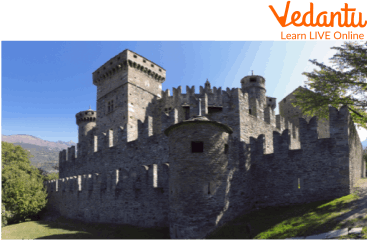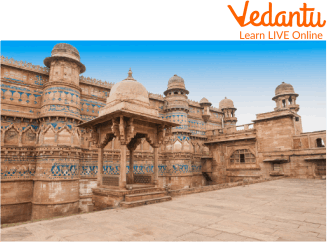




Why Are Castles and Palaces Important in History?
A castle is a fortified structure built primarily by the nobility or royalty and military orders during the Middle Ages. Scholars debate the definition of a castle, but most agree that it is the private fortified residence of a lord or noble. This is distinct from a palace, which is not fortified; a fortress, which was not always a residence for royalty or nobility; a pleasance, which was a walled-in residence for supremacy but not adequately fortified; and a fortified settlement, which was a public defence - despite many similarities. Now, dive in and see more about the difference between castle, palace, and fort.
History of Castles
Ancient walled towns such as Troy, Babylon, Jericho, and Mycenae gave rise to castles. These cities were fortified with massive, high stone walls and gates that restricted traffic passage. Soldiers would stand guard at the gates and on the walls to deter intruders.
The Norman invaders built castles in England to serve as a defensive barrier and to appease the local populace. To protect the territory he had conquered, William the Conqueror fortified strategic locations as he advanced through England.
Types of Castles
There are three major types of castles.
Medieval Castle
Motte-and-Bailey
Stone Keep
Medieval Castles
From the 11th century CE, rulers built medieval castles to demonstrate their wealth and power to the local populace, to provide a place of defence and safe retreat in the event of an attack. Castles were also built to defend strategically important sites such as river crossings, passages through hills, mountains, and borders, and to serve as a place of residence.

Medieval Castle
Motte and Bailey Castles
When the Normans invaded England in 1066, they brought the Motte and Bailey fortresses with them. The Normans are thought to have erected up to 1000 Motte and Bailey castles in England. The terms "motte" and "bailey castle" come from Norman French words for the mound and enclosed land. The Keep was the most important portion of these castles.

Motte and Bailey Castle
Stone Keep Castles
In the Stone Keep, a stone tower placed on the castle's highest point was a central feature. It was normally very tall with thick stone walls and was where the owners would have lived. Not all keeps were the same, but there would have been battlements on top of the keep to give the defence.

Stone keep Castle
Palaces
A palace is a magnificent residence, particularly a royal mansion or the abode of a head of state or other high-ranking dignitaries, such as a bishop or archbishop. The word comes from the Latin ‘paltium’, which refers to the Palatine Hill in Rome, which housed the Imperial mansions. Most European languages have a variation of the phrase (Palais, Palazzo, Palacio, and so on), and many use it to refer to a broader range of structures than English.
In various regions of Europe, the term refers to huge private mansions in cities, particularly those of the nobility; the term for a large country house is generally different. Many old palaces are currently used as legislatures, museums, hotels, or office buildings. The term is often used informally.
History of Palaces
A palace is a royal house, and a seat of administration or a religious centre. The term derives from Rome's Palatine Hill, where the Roman emperors built their homes. A palace should be distinguished from a castle, which was initially a fortified residence.
In the following Middle Ages, the lavish mansions of the aristocracy of all levels in England, France, and Spain became known as "palaces" (as did the exiled popes' residence in Avignon), and the term was later applied to several enormous and imposing buildings, both public and private.
What is the Difference Between Castle and Palace?
The difference between castle and palace is that a castle is a huge, fortified dwelling or set of buildings with thick walls that can withstand invasions. They were once inhabited by a prince or nobility and served as command posts for the surrounding area.
On the other hand, a palace is built for elegance, lavishness, and luxury. They don't have defensive walls, moats, or cannons; instead, they have a gilded-chic aura.
Forts
A fortified area is surrounded by a solid wall where soldiers are stationed and designed by the military to fend off an invasion. The forts were built to influence the people and to display a king's wealth, power, and glory. The majority of the forts were castles. However, the British referred to castles as forts throughout the 17th and 18th centuries. The majority of the forts were built between 1300 and 1800 A.D.

Historic Fort of India
Difference Between Castle, Palace, and Fort
The huge difference between a castle palace and a fort is that a palace is frequently used for administrative duties, as well as the residence of prominent people and decorative structures. A fort is a temporary and/or tiny defensive construction. A castle is a permanent and/or substantial defence.
A castle is a cross between a fort and a palace in that it serves as the local administrative centre of the feudal world, a prestigious house for its owner, and a defensible building, ensuring its dominance over the surrounding region.
Summary
In this article, we have learnt about the differences between castles, palaces, and forts. Forts were frequently built at key spots on the landscape or already situated in key locations. Palaces were often built where rivers or roadways met. They were constructed to protect the local towns, cities, or main roads. A castle is a huge building or set of buildings fortified against attack with thick walls, battlements, towers, and, in many cases, a moat. It is a fortified enclosure, structure, or position that can be defended against an enemy.
FAQs on Castles and Palaces Explained: EVS Live
1. Name three Indian forts.
Some forts in India are: Mehrangarh fort, Red fort and Bhujia fort.
2. Name three Indian palaces.
Some palaces in India are: City Palace - Udaipur, Mysore Palace and Marble Palace.
3. Name three famous castles.
Some castles in India are: Himeji Castle, Peles Castle and Bran Castle.









